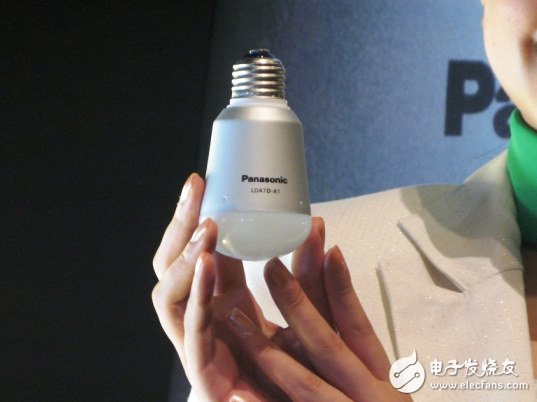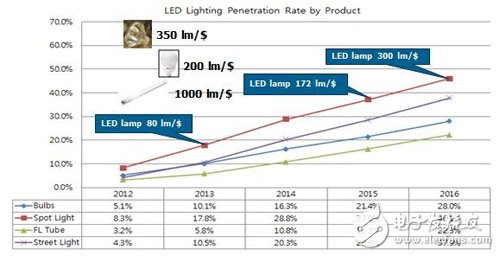The design of light-emitting diode (LED) bulbs is constantly being updated. With the gradual saturation of the display backlight application market, LED manufacturers have gradually shifted their development focus to the field of lighting, and introduced innovative design products such as full-circular or disposable light sources to attract consumers' attention. Seize the profit opportunity.

In recent years, the light-emitting diode (LED) industry has attracted much attention, for no other reason, because the attention received by LED is far greater than the actual results of profit. Of course, from many perspectives, Taiwan ’s LED industry is a crime of non-war. After all, other countries have policy support, and Taiwan has no resources and no market to support the LED industry.
In terms of TV backlight applications, the penetration rate of LED backlights will reach 91.5% by the fourth quarter of 2013, and the penetration rate of LED backlights in TV backlights is expected to reach 100% in the fourth quarter of 2014, mainly due to In order to enhance the added value of brand factories, LEDs are mostly used in the design of products. On the other hand, due to the reduced demand of CCFL material suppliers, the relevant raw materials required by CCFL have been slowly discontinued, making backlighting mainstream Move closer to the LED light source.
As the backlight application market has grown to near saturation, the industry has shifted its focus to LED lighting applications. After years of technological progress in lighting applications, LED applications have slowly begun to replace traditional incandescent bulbs, and their penetration rate is shown in Figure 1.

Source: NPD DisplaySearch
Figure 1 LED lighting penetration rate of different light source products
The rapid growth momentum of the LED lighting market in 2013 is mainly divided into commercial lighting and government-subsidized street lamp-related markets. The main growth momentum of commercial lighting comes from bulb lamps and lamp tubes. Since commercial lighting applications have been turned on for a long time, such as basements or lane lights, most of them are turned on 24/7, so power saving is still the main replacement for LED light sources Momentum, as the nuclear energy issue in Taiwan is still controversial, rising electricity costs are an inevitable trend. NPD DisplaySearch predicts that the overall demand for LED alternative light sources in 2013 will be 1.5 billion, and the penetration rate of bulbs will be 10.1%, with a total of 4.33 The penetration rate of spotlights is 17.8%, the total number is 713 million, the penetration rate of the lamp is 5.8%, the total number is 223 million, and the penetration rate of street lamps is 10.5%, the total number is 68 million.
The main promotion areas for the government to replace LED lamps are Mainland China and emerging markets, such as Brazil, Russia and Mexico. As for the consumer market, the highest acceptance is still in Japan. The main reason is the high price of energy-saving lamps or long lamps in Japan. In recent years, major consumer brands in Japan: Panasonic, Toshiba ( Toshiba, NEC, Sharp, etc. are all competing to launch various types of LED lamps and replacement LED bulbs.
Traditional incandescent lamps are divided into several main specifications, 25 watts (W), 35 watts, 40 watts, 60 watts, 75 watts, 100 watts, 125 watts, and 150 watts, because the luminous efficiency of incandescent lamps is stable and will not improve anymore So the equivalent brightness is about 200 lumens (lm), 325 lumens, 450 lumens, 800 lumens, 1,100 lumens, 1,600 lumens, 2,000 lumens, 2,600 lumens. There are two main points for LED bulbs to replace existing incandescent bulbs:
Brightness / size specifications are equal
Manufacturers should pay attention to the design of products, the brightness of existing LED bulbs is related to the brightness that can be emitted per unit area. On the other hand, a bulb size is about 60 millimeters (mm) & TImes; 106 millimeters, consumers are already accustomed to the size of traditional bulbs, so when LED bulbs are designed, the appearance size can only be reduced but not enlarged .
Price close to incandescent bulbs
Although the biggest benefit of LED bulbs is environmental protection and power saving, the average consumer first notices the price when choosing a product. The current price of bulbs of well-known brands is about NT $ 35 ~ 250, and the price of LED bulbs with corresponding specifications is about two to three times that of incandescent lamps. Although the price difference can be compensated by the saved electricity costs, However, because the electricity rates of different countries are not the same, the benefits of electricity savings in the short term are also different.
Bulbs move towards full-circumference design
In order to make the bulb light closer to the light type emitted by ordinary bulbs, various manufacturers began to adopt the all-circular design. The design purpose of the all-circular design is to improve the performance of LED lights, but the price remains unchanged. That is to say, each manufacturer Want to use the technical ability to overcome the optical design in order to achieve the customer's ideal light type requirements. It is worth noting that at present, the appearance of the bulb lamp has not been standardized, and it still belongs to the situation of the group's separatism (Figure 2).

Source: NPD DisplaySearch
Figure 2 The design concept of different bulbs
Disposable light source concept attracts attention
What concept will LED bulbs be designed in the future? Taiyi Energy Saving puts forward the concept of disposable light source. In the past, the design focus of LED bulbs was on the integration of light (LED light source), machine (bulb mechanism design), electricity (power supply design), and heat (bulb heat dissipation), because the light source is The most important part, so in the past, LED light sources accounted for more than 50% of the total bulb cost, but with the oversupply of the LED industry in recent years, the price of LED light sources has fallen sharply, and now the proportion of light sources has fallen to 30% Around, and because the luminous efficiency of LED light sources continues to improve, the number of used particles continues to decrease, and the life span continues to increase, the overall lighting system adoption cost is expected to decline further.
Nevertheless, compared to the life of the LED itself, the life of the LED power supply materials such as resistors or capacitors is shorter, so the actual use case is often a power failure that causes the LED bulb to fail, and because the design of the LED bulb is an integrated architecture Therefore, when the power supply is damaged, other intact components such as LED light source and heat dissipation mechanism can only be discarded together, causing pollution instead.
Therefore, Taiyi Energy Saving puts the design focus on the protection technology of power supply parts that is most likely to be damaged due to heat, and changes the cheap and mass-manufacturable LED light source to a disposable architecture. If the LED lamp does not consider to provide complete heat dissipation, a low-cost solution can be adopted in the heat dissipation material, and because the LED light source does not consider life, the chip can be driven by high current. When the brightness of the LED light source is attenuated, the power supply part can still be used. Simply replace the LED light source to restore the original brightness. This new concept subverts the idea that LED lights must have a long life.
The following is an analysis and suggestions on the design direction of LED bulbs in 2013.
· If the LED lights are mainly based on OEM or mass production, there is no need to design novel appearances. The consideration should be given to the consideration of automated production, and diversified designs should be avoided as much as possible.
· If selling under its own brand, in addition to designing a novel appearance, the most important thing is price.
· The design concept extends from two-dimensional (2D) surface light source to 3D stereo light source
The original light shape of traditional tungsten light bulbs and energy-saving bulbs is 320 degrees light emission, and LEDs are limited by the packaging structure. The traditional solutions are all directional light sources, which are more suitable for spotlights with stronger directivity. Candle light applications are restricted. Most of the traditional methods use secondary optical elements to improve the light shape, but the effect is limited and the cost is increased. In 2013, the design trend of bulb lamps will mainly be based on the improvement of LED light sources, and columnar or linear light sources will gradually become the mainstream.
Looking forward to 2013, LED lighting is the bright spot in the future. According to the NPD DisplaySearch report for the first quarter of 2013, the penetration rate of LED lighting was 10.6% in 2013. It is estimated that it will increase to 26.4% in 2016, indicating that LED lighting still has great growth Space, it will grow slowly and healthy, and the bulb lamp will be one of the most important products. Because bulb lamps are the closest to consumers and prices continue to fall; as prices are no longer a barrier to sales, bulb lamp designs will focus more on luminous quality and consumer experience.
Not only that, due to the low entry barrier to the LED market, there will be a variety of LED bulb designs on the market. In the future, LED bulb manufacturing companies, whether they want to take a unique design and own brand, or use a lower price or a large number of original equipment manufacturers (OEM) OEM model, they must pay attention: no matter how unique the design or how good Luminous quality, without price support or government policy, consumers do not pay. To explore the main problems of the LED industry, the supply side is still too chaotic and oversupply. Therefore, the LED supply chain will continue to integrate in 2013. When the demand continues to increase and the supply gradually converges, the LED lighting market will still grow rapidly in 2013, and the business opportunities remain Look pretty.
Corn Sheller,Hand Corn Sheller,Corn Sheller Machine,Hand Crank Corn Sheller
Hunan Furui Mechanical and Electrical Equipment Manufacturing Co., Ltd. , https://www.thresher.nl